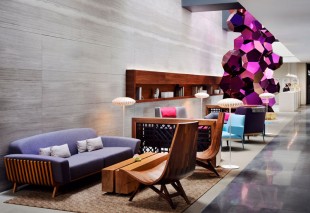

Design case study: InterContinental Dubai Marina

Since its soft opening, the long awaited InterContinental Dubai Marina was already getting good reviews as one of the rare hotels in the region that successfully combines dual concepts — of a hotel and of a museum. Following the client’s brief to create the hotel for those who prefer to “live in” rather than to “stay at”, the design concept was conceived by Draw Link Group and it revolves around a contemporary museum atmosphere punctuated by different artworks that are scattered around.
Sharing a podium with two residential towers in the Bay Central development, this five-star hotel is owned by Dubai-based developer Select Group and is composed of 39 floors, has 328 hotel rooms and residence suites, and six food and beverage outlets.
“When we set out on this journey, our intention was to not only differentiate the product in terms of service by partnering with a world class brand and operator such as InterContinental, our intention was to also differentiate the product in terms of its design identity,” says Rahail Aslam, CEO of the Select Group.
“The hospitality market in the UAE follows a predominantly traditional style of interior design, so our brief to Draw Link Group was that form was definitely to follow function, but at the same time to create a design that was minimalist with clean lines. A contemporary yet inviting space that would make a striking first impression and leave a lasting impact on guests. With Giacometti-inspired sculptures and fascinating contemporary art installations, Draw Link not only delivered our vision but managed to exceed our expectations.”
The most challenging objective for the designers was to reconcile the client’s brief for innovative and distinctive interiors while offering the comfort of a five-star hotel, for which InterContinental is known.
Draw Link Group chairman Daousser Chennoufi explains: “To be honest, it wasn’t easy in the beginning to create this balance. InterContinental has its own standards and brand guidelines, but they were very cooperative. It was a new adventure for all of us — the owner, the hotel operator and for us, but we all believed that this hospitality market is saturated with standard five-star hotels and that we needed to offer a different kind of experience to the guests who appreciate both luxury and modern design.”
Positioned in unexpected locations and yet forming an integral part of the main design, the artworks range from gigantic sculptures to subtle engravings and paintings. In addition to their aesthetic benefits, the artworks were conceived as a specific way of creating landmarks and helping guests to navigate through the hotel.
Article continues on next page...
“The idea for the lobby was to create a volume by using very simple materials, such as stone and wood and with the use of high ceilings, maximising the natural daylight,” says Chennoufi.
“As for the artworks, we have designed many iconic pieces such as the pink sculptures, which can be named a symbol of the hotel. It is the first thing you see when entering the hotel and represents a complex structure of two multifaceted geometric towers made from a reflective stainless steel in a vibrant pink colour. Each sculpture is 7m high and goes up toward the ceiling.”
All the F&B outlets are also themed, each of them holding a different concept, which makes them stand out from one another. The Accents, all-day dining restaurant, has an open kitchen where the chefs prepare dishes on the spot.
To make the food stand out, designers used a white solid surface for the buffet counter tops.
“We wanted to give more importance to the food that is served, so the entire space is designed to be neutral with the exception of the buffet counter, which looks like a sculpture. We used a white solid surface on the buffet counter tops to make the food stand out,” says Chennoufi. With some statement art pieces and a vast collection of designer furniture, the YNot wine bar has a completely different look and it is planned to become a new meeting point with direct access to Dubai Marina Walk.
“With different types of chairs, tables, bar stools and art pieces that we collected from everywhere, YNot is a casual bar that has an aged look. Trying to convince the hotel operator to have more than 10 furniture brands in just one space was one of the struggles, since this was not the standard approach. However, we didn’t want to choose an easy way and we wanted to create an atmosphere to suggest the bar has already existed for years.”
For the rooms and serviced apartments, Chennoufi says that they tried to use all advantages of the Marina views and abundant daylight to make the rooms brighter and more luxurious. The hotel features a considerable selection of natural materials — stone, marble and wood — in a variety of textures and shapes; as well as the use of solid surfaces in the rooms that are a signature feature of Draw Link’s designs.
“Natural daylight and stunning views are the new synonyms for luxury,” concludes Chennoufi.